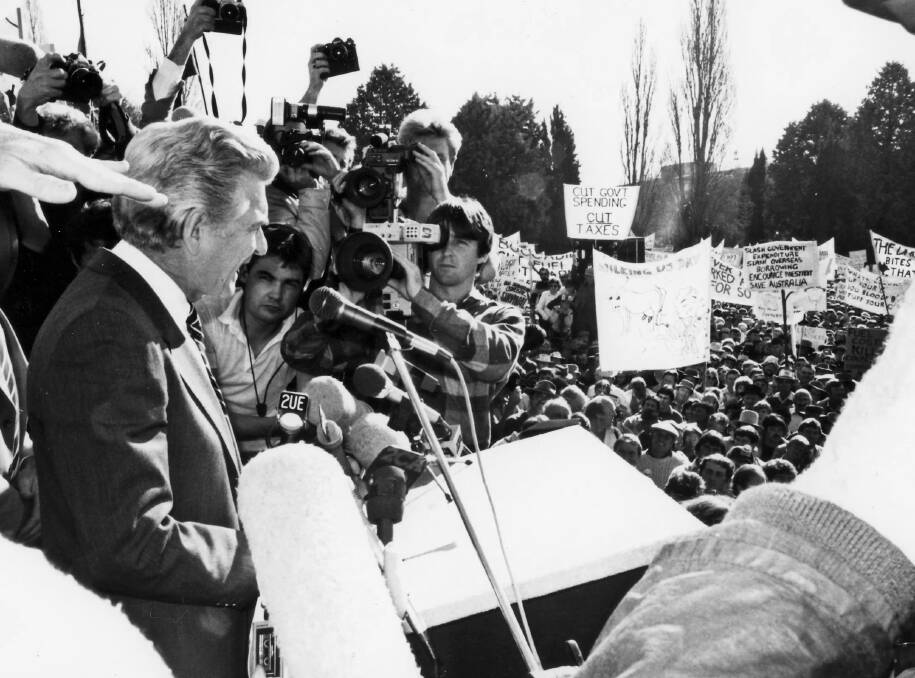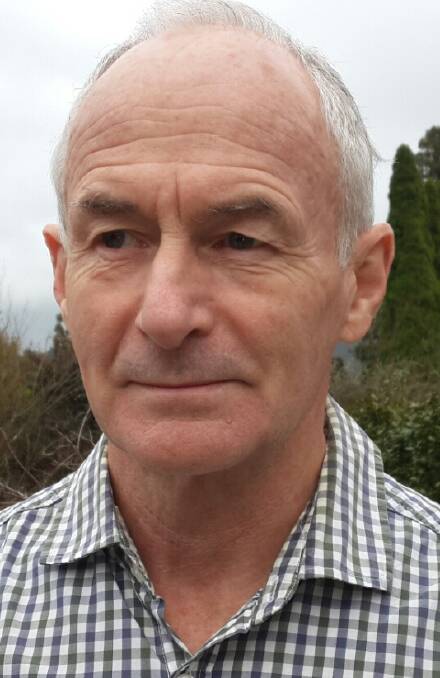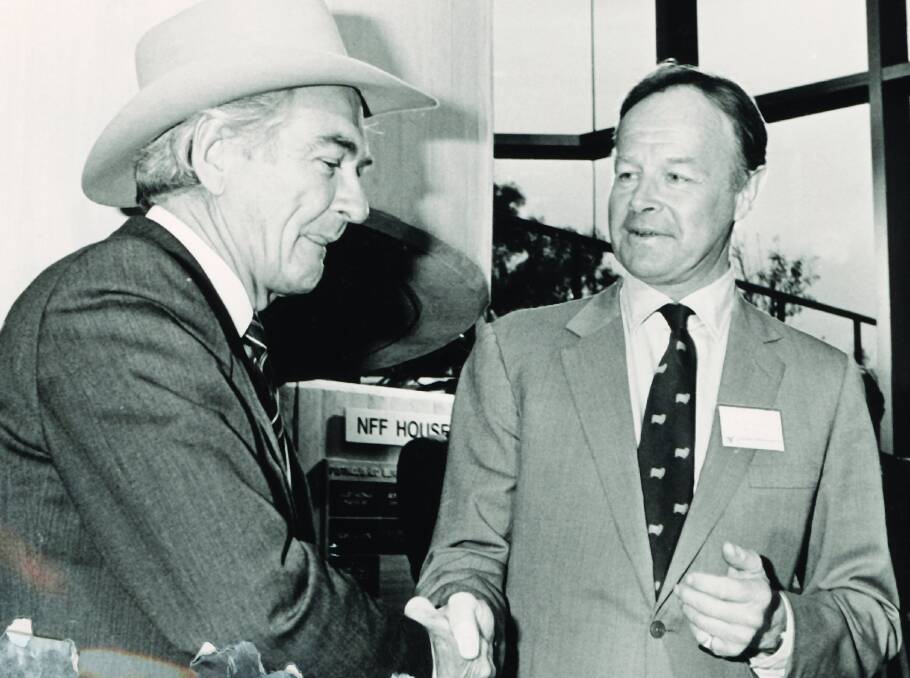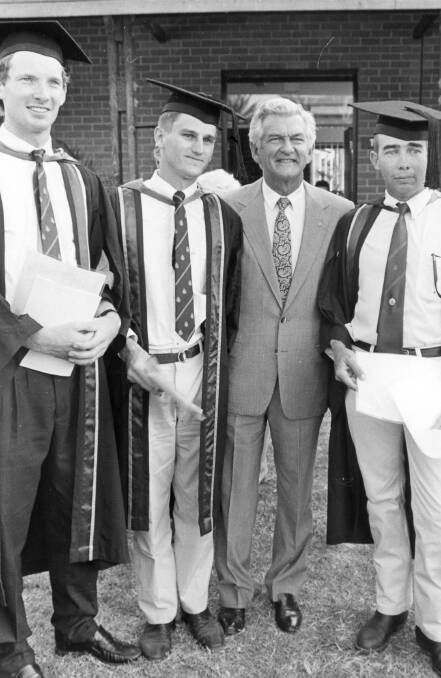
Long-time union boss, Bob Hawke's sudden ascendancy to the Labor leadership and then Prime Minister's job in 1983 was met with widespread unhappiness in rural Australia, but he soon achieved economic changes warmly endorsed by the farm sector.
Subscribe now for unlimited access to all our agricultural news
across the nation
or signup to continue reading
Within a year of taking power Labor had floated the dollar, nailed down a wage accord between unions and business leaders, and begun working on cutting import tariffs.
Conversely, the new government also provoked Australia's biggest mass demonstration of farmer anger in 1985.
About 45,000 country people swarmed into Canberra to rally at Parliament House, angry about high interest rates and fuel costs, tax issues, poor farm commodity prices, an army land grab in rural NSW, trade union wage and work demands, and more.
Bob Hawke braved the crowd and was jeered repeatedly, but persisted, promising the upcoming Federal Budget would address farm cost concerns.
The Hawke-era economic reforms quickly became a period of significant importance for export industries, particularly agriculture and mining.
- Garry Goucher, former NFF economist
"While a large number of farmers would never have trusted a Labor government, a begrudging respect for Bob Hawke and the good things his government achieved was generally acknowledged after a while," recalled former National Farmers Federation economist, Garry Goucher.
"The Hawke-era economic reforms quickly became a period of significant importance for export industries, particularly agriculture and mining.
"Hawke's cabinet also had more ministerial talent than we've probably seen in any government since."
Mr Goucher, who held economic policy roles at NFF from 1981 until 1995, said deregulating the currency quickly spawned a new level of macro economic literacy in rural Australia, including an appreciation of a lower dollar's advantage in export markets and the cost of tariffs on imports such as fertiliser, tractors, ag bikes and new-generation farm chemicals.
The NFF, just four years old when Hawke became Prime Minister, was fighting hard against union power, a blow out in farm sector wages and arguing for more flexibility in the Australian economy.
"NFF demonstrated to the government it was only interested in the issues impacting on agriculture, not the politics," Mr Goucher said.

"We broadly wanted a lot of the same things on the Hawke-Keating economic reform agenda.
"Floating the dollar was certainly welcomed, although initially the currency's value actually rose, which was a bit concerning for a while."
Many in the farm sector were surprised to find Labor's Bob Hawke, who died on Thursday, bringing trade benefits to the export sector and freeing up the economy.
Hawke's government, under agriculture ministers John Kerin and Simon Crean, also famously helped ease the dairy industry through the early stages of deregulation.
The Closer Economic Relations deal signed with New Zealand in the last year of the Fraser Government set the highly regulated Australian dairy industry on the path to deregulation.

While not always enjoying good relations with the government of the day, the NFF, led by its tough talking president, Ian McLachlan, enjoyed "pretty good and fruitful access to Hawke and his cabinet".
"The government had a very focused, very professional and very smart leadership team," said Mr Goucher.
Talented team
Hawke's "team" included West Australian graingrower, Peter Walsh, a strauch advocate of economic policies to help the resources and farm sector become more globally competitive; reform-focused Industry Minister, John Button, and economist and poultry farmer, John Kerin, who became Primary Industries Minister.
"Kerin was pretty well respected as somebody who understood agriculture and worked hard to get the government delivering some good policies.
"I think research and development corporations are probably his, and the Hawke Government's, greatest legacy for the industry.
"He got the rural sector to commit to paying money towards its own research needs, even though the concept of a funding joint ventures with government was eyed with a lot of initial suspicion."

Dairy deregulation
"Dairy was very much a part of the Hawke's consensus approach with both farmers and manufacturers working closely with government," recalled John McQueen, who was chief executive officer of Australian Dairy Farmers at the time.
During this period the government worked closely with industry to achieve the best outcomes possible within the broader freer economic environment created by the Hawke-Keating reforms.
The 1986 Kerin Plan introduced national marketing arrangements to support the price of Australian dairy products sold on the domestic market with a milk levy.
This was reworked under the 1992 Crean Plan to meet Australia's obligations under the World Trade Organisation agreement and further amended in 1995 with a gradual winding down of supports through to full deregulation in 2000.
Under the arrangements, the industry was given 14 years to move to deregulation.
However, Mr Goucher said the Hawke era was far from golden for farmers, especially in the late 1980s when the newly deregulated banking industry's liberal lending habits collided with soaring interest rates at almost 20 per cent to trigger big numbers of farm foreclosures and business bankruptcies.
- Start the day with all the big news in agriculture! Click here to sign up to receive our daily Farmonline newsletter.

